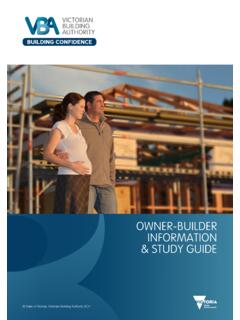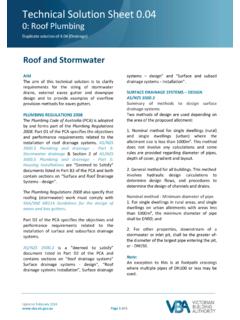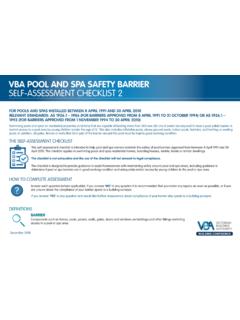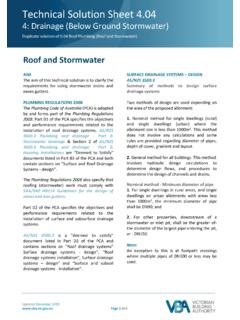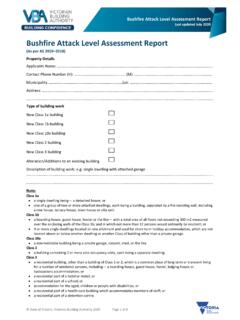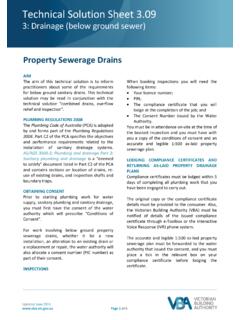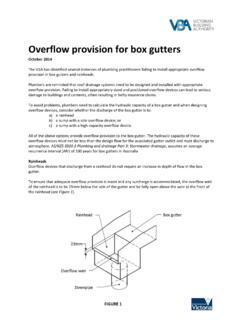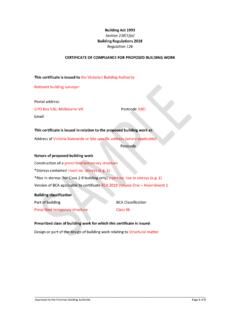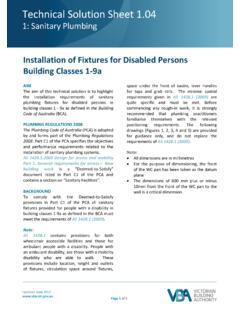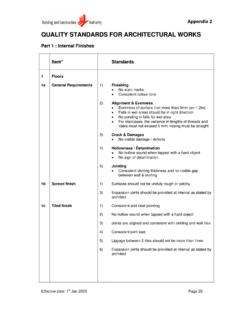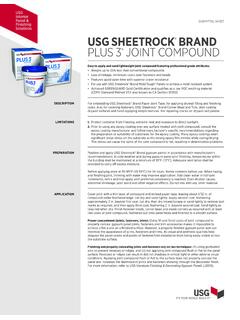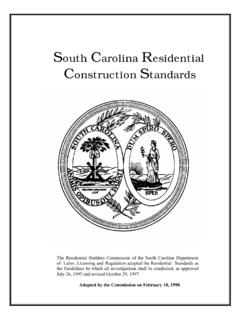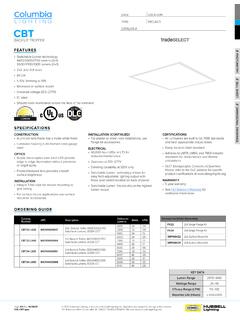Transcription of Guide to Standards and Tolerances (currently under review)
1 Guide TO Standards AND Tolerances 20152 VBA | Guide TO Standards AND Tolerances 2015 FOREWORDThe Guide to Standards and Tolerances (the Guide ) has been developed for use by builders and building owners as a convenient reference for acceptable Standards of workmanship in domestic building construction. It is intended to address areas that are not prescribed under legislation or under a domestic building , parties to a building contract can agree on the Standards they consider appropriate to their building project. Preferably, that agreed scope and Standards of work is comprehensively detailed in the contract documents.
2 Where it is not, there is risk of dispute at a later the parties can agree on applicable Standards , they cannot apply Standards lower than those required by building content of this Guide is based on technical Standards and industry Tolerances that describe (or refer to) what is considered an acceptable standard of finished workmanship in domestic building should be understood that this is a Guide only and that all other documents prescribing statutory and contractual requirements, relevant to the contract, take precedence over this VBA | Guide TO Standards AND Tolerances 2015 AcknowledgementThe Guide to Standards and Tolerances 2015 was produced by the Victorian Building Authority.
3 All information, diagrams and materials included in this publication, except those expressly indicated as belonging to Standards Australia International Limited (SAIL), are the property of the Victorian Building and materials included in this publication, the copyright of which is owned by SAIL, have been reproduced by the VBA with the kind permission of the copyright owner and SAI Global Limited (SAI). For the reader s convenience, we have indicated the relevant Australian Standard which references the diagram or materials in question. These are all available for purchase from SAI. For further information, please visit the SAI website at content in this publication is provided for information purposes only.
4 Although the Victorian Building Authority (VBA) believes that all information contained in this document is accurate and reliable as at the date of publication, the information must not be relied on or regarded as legal advice. The VBA provides no warranty about the accuracy, reliability or authenticity of any information or material contained in this publication, and accepts no liability whatsoever for direct or consequential loss or damage to any person in connection with the information or advice (or the use of such information or advice) which is provided in this publication or incorporated by reference.
5 Information is provided on the basis that all persons accessing this publication or any materials referred to in it, do so at their own risk and undertake responsibility for assessing the relevance and accuracy of any and all Victorian Building in the content and design of this publication including all text, logos, diagrams and images, is owned by the Victorian Building Authority (except to the extent a different copyright owner is expressly identified in the publication).Except in the limited circumstances set out in the Copyright Act 1968 (Cth), no part of this publication must be reproduced, copied, adapted, modified, communicated or otherwise used without written permission from the Victorian Building Authority (which may be withheld at the Victorian Building Authority s absolute discretion).
6 4 VBA | Guide TO Standards AND Tolerances 2015 CONTENTSA Introduction 9B Authority of the Guide 10C Application of the Guide 11D The measurement of time 11E The measurement of Tolerances 12F Inspecting surfaces from a normal viewing position 14G Remedial work 15H Responsibility to rectify 15I Renovations, alterations and extensions 16J Recycled materials 16K Building maintenance Care of the building and site after completion 17L Australian Standards and other referenced material 17M Schedule of References used in this Guide 181 SITEWORKS (PAVING AND LANDSCAPING)
7 Cracking in concrete paving finish to external concrete paving Surface drainage 202 FOOTINGS, SLABS AND SETTING OUT Foundation and site drainage maintenance after occupation Footings and slabs Setting out the site External building dimensions Measuring internal building dimensions Building dimensions Finished floor levels Levelness of concrete floors Dimensions of building elements Cracks in concrete slabs finish to concrete slabs Repairs to exposed concrete slabs 243 MASONRY Masonry types Damage to masonry walls Movement; control joints in masonry walls Masonry construction Blending and matching of masonry repair work Blending and matching of masonry new work Masonry facing Mortar for masonry Voids and holes in mortar Cracked masonry unit Cleaning.
8 Mortar smears and stains 315 VBA | Guide TO Standards AND Tolerances Masonry inside garages and similar spaces and under applied finishes Vertical alignment of perpend joints Horizontal alignment of bed joints Base bed joint and base row of masonry Masonry that overhangs concrete slabs Damp proof courses Raking of joints Brick sills, sill tiles and shrinkage allowance for timber framing 324 FRAMING Verticality or plumbness of stumps or piles Verticality or plumbness of steel and timber frames and exposed posts Straightness of steel and timber frame surfaces Packing under bearers Timber shrinkage Treads and risers in timber stairs Fixing stud walls to concrete slabs Bottom plates that overhang concrete slabs 365 WALL CLADDING Leaks in wall cladding Wall cladding 376 ROOFING Leaks in roofing.
9 Flashings and accessories Roof cladding Roof tiles Roof tile pointing Overhang of roofing (tiles and sheet roofing) Cutting of roof tiles Dry valley construction Undulating tiled roof lines Alignment of trusses Verticality or plumbness of trusses 407 PLUMBING Plumbing Positioning of gutters Water retention in gutters Joints in gutters Fixing of gutters and downpipes Flashings Water hammer Pipe penetrations through external walls and inside cupboards Water supply fixtures Water drainage from baths, basins, sinks.
10 Troughs or the like Parapet flashings/cappings 456 VBA | Guide TO Standards AND Tolerances 20158 WINDOWS AND DOORS Installation of external windows and doors Weather-tightness of windows, doors, and window and door frames Door furniture Internal door clearances Distortion of doors Sealing of door edges Operation of windows and doors Bowed window heads, sills and jambs 479 PLASTERING AND RENDERING Verticality or plumbness of internal and external wall surfaces Straightness of internal and external wall surfaces Matching and repairing existing rendered surfaces Cracking and other blemishes in rendered or hard plastered surfaces on a masonry substrate Repairs to applied finishes Movement.
